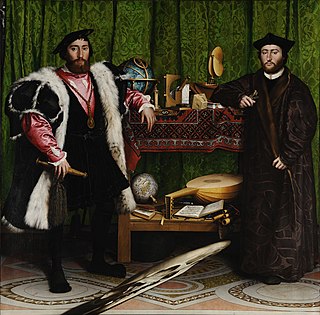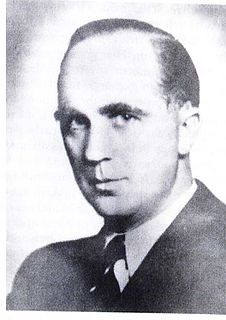Otto von Erdmannsdorff (22 October 1888 – 30 December 1978) was a German diplomat who served as ambassador to Hungary under the Nazis from 1937 to 1941, and was later acquitted of war crimes in the Ministries Trial.

Germany, officially the Federal Republic of Germany, is a country in Central and Western Europe, lying between the Baltic and North Seas to the north, and the Alps, Lake Constance and the High Rhine to the south. It borders Denmark to the north, Poland and the Czech Republic to the east, Austria and Switzerland to the south, France to the southwest, and Luxembourg, Belgium and the Netherlands to the west.

An ambassador is an official envoy, especially a high-ranking diplomat who represents a state and is usually accredited to another sovereign state or to an international organization as the resident representative of their own government or sovereign or appointed for a special and often temporary diplomatic assignment. The word is also often used more liberally for persons who are known, without national appointment, to represent certain professions, activities and fields of endeavor such as sales.

Hungary is a country in Central Europe. Spanning 93,030 square kilometres (35,920 sq mi) in the Carpathian Basin, it borders Slovakia to the north, Ukraine to the northeast, Austria to the northwest, Romania to the east, Serbia to the south, Croatia to the southwest, and Slovenia to the west. With about 10 million inhabitants, Hungary is a medium-sized member state of the European Union. The official language is Hungarian, which is the most widely spoken Uralic language in the world, and among the few non-Indo-European languages to be widely spoken in Europe. Hungary's capital and largest city is Budapest; other major urban areas include Debrecen, Szeged, Miskolc, Pécs and Győr.
A member of the Saxon juridical service before the First World War, and a participant in that war, Von Erdmannsdorff afterward held diplomatic posts in Mexico, China, and Tokyo. He took up his post as ambassador to Hungary on May 11, 1937. [1] Although serving as ambassador for Hitler's government during a critical period, he was not himself a Nazi: the U.S. Ambassador to Hungary at the time, John F. Montgomery, mentioned that von Erdmannsdorff "almost resigned at one time because he didn't want to cope with the Nazis", [2] and Hungarian regent Miklós Horthy described him as "the last of the professional German diplomats". [3] He nonetheless became a nominal member of the party in 1937. [4] He was replaced as ambassador in July 1941 by Dietrich von Jagow, [1] a party member rather than professional diplomat. [3]

The Kingdom of Saxony, lasting between 1806 and 1918, was an independent member of a number of historical confederacies in Napoleonic through post-Napoleonic Germany. The kingdom was formed from the Electorate of Saxony. From 1871 it was part of the German Empire. It became a Free state in the era of Weimar Republic in 1918 after the end of World War I and the abdication of King Frederick Augustus III of Saxony. Its capital was the city of Dresden, and its modern successor state is the Free State of Saxony.

Mexico, officially the United Mexican States, is a country in the southern portion of North America. It is bordered to the north by the United States; to the south and west by the Pacific Ocean; to the southeast by Guatemala, Belize, and the Caribbean Sea; and to the east by the Gulf of Mexico. Covering almost 2,000,000 square kilometres (770,000 sq mi), the nation is the fifth largest country in the Americas by total area and the 13th largest independent state in the world. With an estimated population of over 120 million people, the country is the tenth most populous state and the most populous Spanish-speaking state in the world, while being the second most populous nation in Latin America after Brazil. Mexico is a federation comprising 31 states and Mexico City, a special federal entity that is also the capital city and its most populous city. Other metropolises in the state include Guadalajara, Monterrey, Puebla, Toluca, Tijuana and León.

China, officially the People's Republic of China (PRC), is a country in East Asia and the world's most populous country, with a population of around 1.404 billion. Covering approximately 9,600,000 square kilometers (3,700,000 sq mi), it is the third- or fourth-largest country by total area. Governed by the Communist Party of China, the state exercises jurisdiction over 22 provinces, five autonomous regions, four direct-controlled municipalities, and the special administrative regions of Hong Kong and Macau.
Thereafter, he served as Deputy to Ernst Wörmann, who was Chief of the Political Division of the German Foreign Office. [4] Although the Political Division was staffed mainly by civil servants who were either nominal members of the Nazi Party or not members at all, it was nonetheless involved in implementing the Final Solution. [4] This led to von Erdmannsdorff's being charged with war crimes in the Ministries Trial after the war; however, he was acquitted as a result of a determination that he lacked sufficient power and influence to have been able to prevent the crimes. [5]

The Final Solution or the Final Solution to the Jewish Question was a Nazi plan for the genocide of Jews during World War II. The "Final Solution of the Jewish Question" was the official code name for the murder of all Jews within reach, which was not restricted to the European continent. This policy of deliberate and systematic genocide starting across German-occupied Europe was formulated in procedural and geopolitical terms by Nazi leadership in January 1942 at the Wannsee Conference held near Berlin, and culminated in the Holocaust, which saw the killing of 90% of Polish Jews, and two thirds of the Jewish population of Europe.

The Ministries Trial was the eleventh of the twelve trials for war crimes the U.S. authorities held in their occupation zone in Germany in Nuremberg after the end of World War II. These twelve trials were all held before U.S. military courts, not before the International Military Tribunal, but took place in the same rooms at the Palace of Justice. The twelve U.S. trials are collectively known as the "Subsequent Nuremberg Trials" or, more formally, as the "Trials of War Criminals before the Nuremberg Military Tribunals" (NMT).
His memoirs are unpublished, and contain among other things a number of quotations from Horthy recorded during von Erdmannsdorff's four years representing Germany in Hungary. [3]















